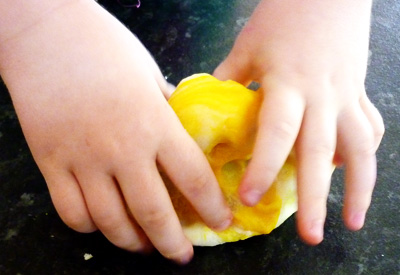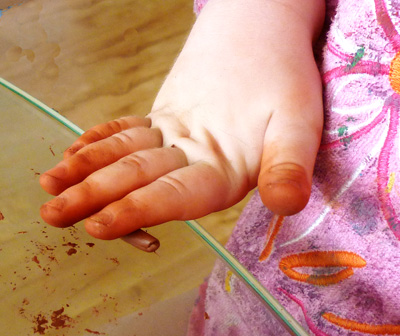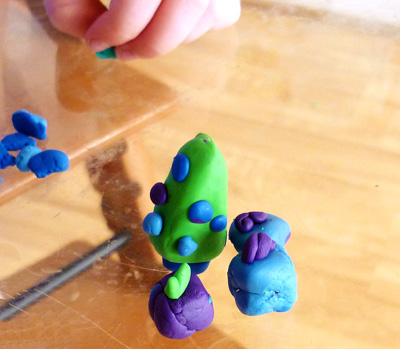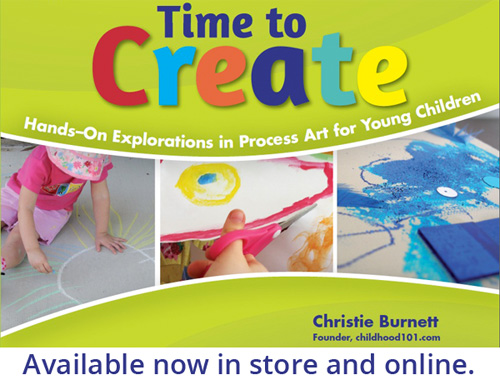Playdough, Plasticine & Clay for Kids: Making Little Hands Stronger
Playing with playdough is fun and most young children love it. But have you ever stopped to thing about how playing around with dough actually helps children to develop control and strength of the muscles in their fingers and hands? Those same little muscles which they need to be good and strong to hold a pencil and write with.
Children benefit from having LOTS of opportunities to work with playdough. Opportunities for…
Immy squeezes and kneads the colouring through the dough
Squeezing and kneading: Make a batch of uncoloured playdough and allow your children to squeeze and knead the food colouring through themselves (if you put the colouring into the middle of the dough and fold it over and then start to knead, it shouldn’t stain fingers too much). Or try kneading dough for pizzas or to make pastries.
Poking holes is lots of fun
Poking and pinching: is great for finger strength. Teaching your child to make pinch pots from clay is one way to encourage a pinching action.
Rolling air dry clay
Rolling: Teaching your child to roll snakes from modelling media with their hands and to flatten dough with a rolling pin engages both the muscles in the hand and in the arm. Rolling a ball of dough involves a different hand action and type of control.
Pizza anyone?
Pressing: Don’t always give your child tools (like rolling pins and cookie cutters) to work with. It is important for children to also learn to use their hands to flatten and shape, maximising the rehearsal opportunity for co-ordination skills (and it also allows for a more creative response with the dough).
Cutting: Cutting rolls of playdough with a plastic knife or a pair of child safe scissors provides another way to practice using these every day tools.
Stamping onto flattened clay with rubber stamps
Stamping: Rubber stamps aren’t just for ink and paper. For a different experience why not try stamping onto flattened dough, plasticine or clay.
Working out shapes and how to attach them involves lots of problem solving
Constructing: Making objects with any of these modelling media involves a variety of construction techniques and plenty of opportunity for planning, problem solving and task perseverance. How will I make this balance? How will I attach this leg? That didn’t work, what else can I try?
Plasticine presents under a plasticine tree
Imagining: As well as being great for fine motor development, there is limitless potential for imaginative play to be found in a ball of dough. At Christmas time, Immy played for ages making and ‘opening’ little plasticine presents under a pretty plasticine tree.
Providing children who have had lots of experience with playdough with different modelling media helps to keep them interested. Have you tried;
- Plasticine or modelling clay: This usually requires more work to soften and model with and is therefore great for strengthening the fingers and hands of older children.
- Clay: If you don’t like the mess factor, look for child friendly air dry clay. Also, look for white porcelain clay rather than the red/brown terracotta variety.
- Salt dough.
What is your child’s favourite way to play with playdough or other modelling media?
Now is the time to create! My new book, Time to Create: Hands-On Explorations in Process Art for Young Children includes an entire section dedicated to ideas for sculpting with kids. Be sure to check it out.









My boys love play doughy. We try and make a new batch of play dough each month and the boys get to choose the colours and experiment with mixing colours. I used to try and make several colours at once but I have got a little lazy and only make one big batch of one colour. Next time I will make a batch of plain and let them knead in the colours of their choice.
Play dough has been such a staple at our place. I find that it’s a really calming activity if someone’s a bit upset too. And we even take some in a ziplock bag on plane rides. My daughter loves modelling best of all, and usually makes cats, ducks and other animals which she then uses for story telling and imaginative play.
We often add other toys, like cars, or plastic animals, or gumnuts and leaves to extend things a bit. And we sometimes add essential oils to the dough, or sand, or glitter, just for a different sensory experience.
Haven’t tried placticine yet, must get some!
Argh my comment got eaten by dodgy internet connection.
My girls enjoy plasticine but not playdough because of the residue it leaves on their hands and the texture of the dough.
We got some great stuff from the therapy shop called ‘Theraputty’ which comes in three different strengths, it is great for building up hand muscles and also acts as a bit of a stress reliever, pulling and stretching and squeezing.
For more creative play we use bread dough or scone dough to make shapes 🙂
Thank you for the Theraputty tip, Marita 🙂
I STILL so enjoy playing with dough, and despite the nasty stains on our dining room floor we are one happy dough-loving family!
Loving the blog Christie..!
xx Charlotta
I LOVE the smell of freshly made dough still warm. Can’t wait to bury my fingers in it and squeeze. We love making things to keep from salt-dough. 🙂
Thanks for the reminder of the wonders of playdough and the recipe for salt dough. I prefer homemade playdough as I don’t worry when my 20 month-old eats it! Mothers’ Group at my place next week – think we might make some playdough!
We love making playdough at home too, it is so much nicer and much more cost effective.
Does anyone know an easy playdough recipe?
THANKS
Hi Natasha, the playdough recipe I use can be found here – https://childhood101.com/2009/06/we-are-reading-3/
Have fun!
Wonderful information Christie 🙂
who can name an activity where dramatic play and clay or dough are combined. ?
My grandson who is 8 yrs old makes models out of plasticine.He would be sitting down watching TV and making a model and within minutes he comes up with a completely brilliant model. At the moment he has 44 models and they are all different. I want to see if I can market these models or if anyone is interested in making a cartoon film.